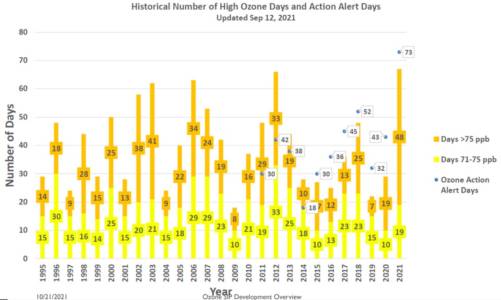by Heidi Leathwood
In the summertime, Denver Metro and North Front Range residents often see road hazard signs warning them of high-ozone and asking them to drive less on those days. These signs are a bit confusing for those who associate the word ‘ozone’ with a layer high in the atmosphere that protects us from the sun’s UV rays. The world came together successfully a few decades ago to solve the hole in the ozone. The ozone we now get repeated alerts about is ozone at ground level–a very serious threat to health. Once you know about the health hazards of ozone, you may wonder why you are being asked to get out of your car and bike or walk in the unhealthy air.
History of ozone in Colorado
The Denver Metro and North Front Range area has been experiencing health-threatening levels of ozone since before 2008, which is when the Environmental Protection Agency (EPA) created the health-based standard of 75 parts per billion (ppb) for short-term ozone exposure. We have never managed to get our levels of ozone to meet that standard. In fact, 2021 was the worst year yet for ozone, with 73 ozone alert days and 67 days of ozone levels above 75 ppb.
 Due to the State’s failure to get this problem under control for so long, the EPA designated the Denver Metro and North Front Range area as a ‘serious’ non-attainment area, and now they are lowering our rating to ‘severe.’ (See this map of area that will be downgraded to ‘severe’.) The state now has to make a new State Implementation Plan (SIP) to get our levels down to a healthy level. None of the previous SIPs have achieved results so we need to demand a much stronger plan this time. A stronger plan on ozone should also help lower the greenhouse gases emitted by the same sources that cause ozone.
Due to the State’s failure to get this problem under control for so long, the EPA designated the Denver Metro and North Front Range area as a ‘serious’ non-attainment area, and now they are lowering our rating to ‘severe.’ (See this map of area that will be downgraded to ‘severe’.) The state now has to make a new State Implementation Plan (SIP) to get our levels down to a healthy level. None of the previous SIPs have achieved results so we need to demand a much stronger plan this time. A stronger plan on ozone should also help lower the greenhouse gases emitted by the same sources that cause ozone.
What is ozone and where does it come from?
Ozone, or O3, is a molecule that has three atoms of oxygen instead of the usual two. Breathing it can exacerbate existing respiratory and cardiac issues, and scar even healthy lung tissue. It is created when certain substances – Volatile Organic Compounds (VOCs) and Nitrogen Oxides (NOx) – react with sunshine (which we have a lot of in the hot summer months). Cars and trucks are one source of these ‘ozone precursors.’ Gas-powered lawn equipment and household cleaners and personal care items emit a surprising amount. But by far the biggest source of VOCs and NOx are oil and gas operations, namely fracking and all the pre-production and production activities that accompany it. Oil and gas operations contribute 37% of total VOC emissions from all sources, and 26% of NOx (see the draft SIP, table 8). Oil and Gas emit more VOCs than on-road sources, off-road sources, and non-oil and gas point sources combined, and 1.33 times more than all non-oil and -gas area sources. But despite fracking’s huge responsibility for this problem, the draft SIP that the state has created allows oil and gas companies to increase their total emissions of VOC and NOx 11% by 2026.
What should the State do?
The government should make rules that hold oil and gas operations accountable. They should pay special attention to areas which are already heavily polluted, especially disproportionately impacted (DI) communities who have borne an excessive burden of pollution of all kinds for far too long. The intention of the Environmental Justice Act (HB21-1266) was to reduce the pollution burden on disproportionately impacted communities and we need bolder action on that. Rules should be passed to prevent new permits if they increase pollution in DI communities. Rules should be created to prevent high-emitting activities in the ‘severe’ nonattainment area during ozone season, and to prevent all oil and gas activities in those areas on high ozone days.
What is 350 Colorado doing?
350 Colorado has joined with other environmental groups this summer to demand that the state do more. Some groups spoke out at the annual retreat of the Air Quality Control Commission. 350 Colorado, Moms Clean Air Force, WildEarth Guardians and Sierra Club collaborated to present an educational webinar. 350 Colorado submitted written comment to the Regional Air Quality Council about the SIP. 350 Colorado, WildEarth Guardians and other groups will soon be formally asking the Colorado Oil and Gas Conservation Commission (COGCC) to make new rules to address ozone and other cumulative impacts – coming soon!
What can I do?
Sign this one-click letter. For greater impact, you can personalize the letter using the talking points in the toolkit below or your own story. When you click send, it will go to Governor Polis, the Colorado Oil and Gas Conservation Commission, the Air Quality Control Commission, the Regional Air Quality Council, and the Air Pollution Control Division.
If you want to take more actions, use this toolkit.
